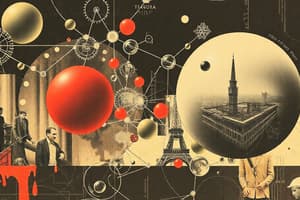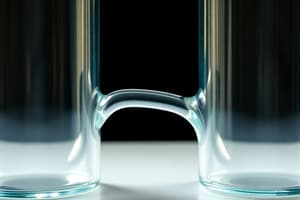Podcast
Questions and Answers
Which gas law states that volume is inversely proportional to pressure at constant temperature and number of moles?
Which gas law states that volume is inversely proportional to pressure at constant temperature and number of moles?
- Boyle's Law (correct)
- Charles's Law
- Avogadro's Principle
- General Gas Law
According to Charles's Law, what is the relationship between volume and temperature at constant pressure and number of moles?
According to Charles's Law, what is the relationship between volume and temperature at constant pressure and number of moles?
- Volume is independent of temperature.
- Volume is inversely proportional to temperature.
- Volume is directly proportional to temperature. (correct)
- Volume is equal to temperature.
Which principle states that the volume of a gas is directly proportional to the number of moles at constant temperature and pressure?
Which principle states that the volume of a gas is directly proportional to the number of moles at constant temperature and pressure?
- General Gas Law
- Boyle's Law
- Avogadro's Principle (correct)
- Charles's Law
What is the Ideal Gas Law equation?
What is the Ideal Gas Law equation?
In the context of kinetic molecular theory, what is assumed about the volume of gas particles?
In the context of kinetic molecular theory, what is assumed about the volume of gas particles?
According to the kinetic molecular theory, intermolecular forces of attraction between gas particles are considered to be what?
According to the kinetic molecular theory, intermolecular forces of attraction between gas particles are considered to be what?
According to the kinetic molecular theory, which of the following is proportional to the average kinetic energy of the molecules?
According to the kinetic molecular theory, which of the following is proportional to the average kinetic energy of the molecules?
According to the kinetic molecular theory, gas particles are assumed to be in what type of motion?
According to the kinetic molecular theory, gas particles are assumed to be in what type of motion?
In ideal gas behavior, what conditions are necessary to neglect attractive and repulsive forces between particles?
In ideal gas behavior, what conditions are necessary to neglect attractive and repulsive forces between particles?
If the temperature is held constant, how does the root mean square speed of gas molecules change as molar mass increases?
If the temperature is held constant, how does the root mean square speed of gas molecules change as molar mass increases?
What is the effect of increasing the volume of a gas at a constant temperature on its pressure?
What is the effect of increasing the volume of a gas at a constant temperature on its pressure?
How does increasing the temperature of a gas in a closed container affect its pressure?
How does increasing the temperature of a gas in a closed container affect its pressure?
Which of the following units is commonly used to measure pressure?
Which of the following units is commonly used to measure pressure?
Which of the following represents standard atmospheric pressure in torr?
Which of the following represents standard atmospheric pressure in torr?
What is the standard unit of volume in gas law calculations?
What is the standard unit of volume in gas law calculations?
What is the effect of strong attractive forces between gas molecules on the compressibility of a gas?
What is the effect of strong attractive forces between gas molecules on the compressibility of a gas?
Under what conditions do real gases tend to behave most like ideal gases?
Under what conditions do real gases tend to behave most like ideal gases?
What does Dalton's Law of Partial Pressures state about the total pressure of a gas mixture?
What does Dalton's Law of Partial Pressures state about the total pressure of a gas mixture?
Which factor accounts for deviations from ideal behavior in real gases?
Which factor accounts for deviations from ideal behavior in real gases?
What is the effect of high pressure on the repulsive forces between gas molecules?
What is the effect of high pressure on the repulsive forces between gas molecules?
What is the value of the compression factor (Z) for an ideal gas?
What is the value of the compression factor (Z) for an ideal gas?
For real gases, when does attraction dominate?
For real gases, when does attraction dominate?
For real gases, when does repulsion dominate?
For real gases, when does repulsion dominate?
At Boyle temperature, the properties of a real gas coincide with those of a perfect gas as pressure approaches which value?
At Boyle temperature, the properties of a real gas coincide with those of a perfect gas as pressure approaches which value?
In van der Waals equation, what does the 'a' constant account for?
In van der Waals equation, what does the 'a' constant account for?
What does the 'b' constant in the van der Waals equation represent?
What does the 'b' constant in the van der Waals equation represent?
According to the van der Waals equation, perfect gas isotherms are obtained at which conditions?
According to the van der Waals equation, perfect gas isotherms are obtained at which conditions?
What is the term for parameters where it is the condition in which the difference between gas and a liquid starts to disappear?
What is the term for parameters where it is the condition in which the difference between gas and a liquid starts to disappear?
According to the principle of corresponding states, real gases exert the same reduced what at the same reduced volume and temperature?
According to the principle of corresponding states, real gases exert the same reduced what at the same reduced volume and temperature?
For which type of gases does the principle of corresponding states work best?
For which type of gases does the principle of corresponding states work best?
Flashcards
Boyle's Law
Boyle's Law
Volume of gas is inversely proportional to pressure at constant temperature and moles.
Charles' Law
Charles' Law
Volume of gas is proportional to temperature at constant pressure and moles.
Avogadro's Principle
Avogadro's Principle
Volume of gas is proportional to the number of moles at constant temperature and pressure.
Ideal Gas Law
Ideal Gas Law
Signup and view all the flashcards
Kinetic Molecular Theory
Kinetic Molecular Theory
Signup and view all the flashcards
Gas Pressure
Gas Pressure
Signup and view all the flashcards
Boyle Temperature (TB)
Boyle Temperature (TB)
Signup and view all the flashcards
Real Gas
Real Gas
Signup and view all the flashcards
Repulsive Forces
Repulsive Forces
Signup and view all the flashcards
Attractive Forces
Attractive Forces
Signup and view all the flashcards
Compression Factor Z
Compression Factor Z
Signup and view all the flashcards
Dalton's Law of Partial Pressures
Dalton's Law of Partial Pressures
Signup and view all the flashcards
Graham's Law of Effusion
Graham's Law of Effusion
Signup and view all the flashcards
Apparent Molar Mass
Apparent Molar Mass
Signup and view all the flashcards
van der Waals equation
van der Waals equation
Signup and view all the flashcards
Corresponding States
Corresponding States
Signup and view all the flashcards
Study Notes
Gas Laws
- Boyle's Law states that volume is inversely proportional to pressure at constant temperature (T) and amount of gas (n)
- Charles’ Law states that Volume is proportional to Temperature at constant pressure (p) and amount of gas (n)
- Avogadro's Principle states that Volume is proportional to the number of moles (n) at constant Temperature (T) and pressure (p)
- The General Gas Law relates volume, number of moles, temperature, and pressure
- This relationship is expressed as V~n.T/p, which leads to the ideal gas law equation PV = nRT
- The molar volume (Vm) can be calculated using the formula Vm = (V/n) = (RT/P)
Kinetic Molecular Theory
- Explains gas behavior through postulates and assumptions
- Gases consist of rigid particles with negligible volume compared to the total gas volume
- These particles are in constant motion, colliding with each other and container walls
- Intermolecular forces are negligible, resulting in perfectly elastic collisions
- Absolute temperature (K) is proportional to the average kinetic energy of the particles
Exam Style Questions Related to the Kinetic Molecular Theory
- The postulate that best explains why gases are easily compressed is that the volume of particles is negligible compared to the total volume occupied
- For an ideal gas, velocity (v) and the square root of temperature (T^1/2) are directly proportional
- Gas pressure is caused by gas molecules hitting the container walls
Root Mean Square Exercise
- Root mean square of N2 molecules (M = 28.02 g mol-1) at 298 K is calculated to be 515 m/s
Root Mean Square Question
- To determine the temperature at which argon has the same root-mean-square velocity as helium at room temperature is required for the question
Ideal Gas
- Achieved under conditions of high temperature (T) and low pressure (P)
- These conditions minimize attractive and repulsive forces between particles and volume of particle
- Physical parameters can be derived from the ideal gas equation PV = nRT
- Molar mass (M) = mRT/PV, density (ρ) = PM/RT, and concentration (C) = P/RT
- R Numerical Values of the Gas Constant: L-atm/mol-K =0.08206, J/mol-K = 8.314, cal/mol-K = 1.987 m³-Pa/mol-K = 8.314, L-torr/mol-K = 62.36
Unit Conversions
- Pressure conversions: 1 atm = 1.01325 x 10^5 Pa; 1 bar = 1 x 10^5 Pa; 1 millibar (mb) = 100 Pa; 1 atm = 1.01325 bar; 1 atm = 760 torr; 1 torr = 1 mm Hg.
- Volume conversions: Utilize the relationship between mL, cm³, L, and m³ with conversion factors of 1000
- Temperature conversions: K = °C + 273 and °C = K - 273.
Exam Style Question on Gases
- Calculating the form of Sulfur in gaseous form
Dalton’s Law Of Partial Pressures
- A mixture of ideal gases, exerts a pressure that’s the sum of pressures
- Total pressure (PT) is the sum of partial pressures (PA + PB + ...)
- The mole fraction (yi) is represented as (molei / moletotal) = (Pi / Ptotal)
Exam Style Question on Gases
- What are the partial pressures of oxygen and hydrogen at 27°C?
Graham’s Law Of Effusion
- The movement of gas particles through a hole
- Average molar mass of the gas mixture is M = ∑yi Mi
Exam Style Question on Gases
- What is the apparent molar mass of air?
Real Gases
- Deviations from ideal gas behavior arise from molecular interactions, especially at low temperatures and high pressures
- Deviations from ideality can be accounted for using: Modified Equations of State, Compression Factor, Fugacity, and Joule-Thomson Coefficient
Real Gases vs Attractive and Repulsive forces
- Repulsive forces are short-range, significant almost in contact, and occur at high pressure (P) and low volume (V)
- Attractive forces are relatively long-range, effective over several molecular diameters, and relevant when molecules are close but not touching
Ideal Gas Behavior vs Attractive and Repulsive forces
- Ideal gas behavior occurs at low pressures, with large volumes and minimal intermolecular forces of attraction (IMFA)
- Attractive forces dominate at moderate pressures where the separation of molecules is a few diameters, leading to increased compressibility
- Repulsive forces dominate at high pressures, with small molecule separations, reducing compressibility
Compression Factor (Z)
- Represents a gas's ability to be compressed at a given condition; for an ideal gas, Z = 1 under all conditions
- At very low pressures, Z = 1, and gases behave nearly perfectly
- At moderate pressures, Z < 1, and attraction dominates with less molar volume
- At high pressures, Z > 1, and repulsion dominates with a larger molar volume
Boyle Temperature (TB)
- The temperature at which a real gas's properties align with those of a perfect gas as pressure approaches 0
Van Der Walls Equation
- Reduction of pressure is proportional to the square of concentration (a is a positive constant)
- Pressure (p) is based on frequency/force of collisions, reduced by attractive forces
- Excluded volume (b) is total volume taken up by molecules, which is four times the volume of the particle
- Perfect gas isotherms are obtained at high temperature and large molar volumes
- Liquids and gases coexist when cohesive and dispersing effects are in balance
- Second term represents the effect of the attractive interactions
- First term arises from the kinetic energy of the molecules and their repulsive interactions
- Van der Waals loops occur when both terms have similar magnitudes
- The critical constants are related to the van der Waals coefficients
- Critical parameters are the conditions wherein the difference between gas and liquid starts to disappear
Principle of Corresponding States
- Real gases at the same reduced volume and temperature exert the same reduced pressure
- Works best with gases composed of spherical molecules
Studying That Suits You
Use AI to generate personalized quizzes and flashcards to suit your learning preferences.





